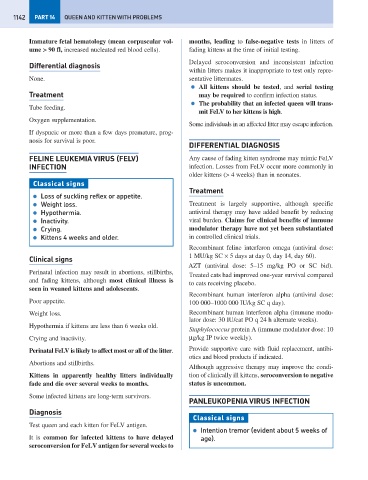Page 1150 - Problem-Based Feline Medicine
P. 1150
1142 PART 14 QUEEN AND KITTEN WITH PROBLEMS
Immature fetal hematology (mean corpuscular vol- months, leading to false-negative tests in litters of
ume > 90 fl, increased nucleated red blood cells). fading kittens at the time of initial testing.
Delayed seroconversion and inconsistent infection
Differential diagnosis
within litters makes it inappropriate to test only repre-
None. sentative littermates.
● All kittens should be tested, and serial testing
Treatment may be required to confirm infection status.
● The probability that an infected queen will trans-
Tube feeding.
mit FeLV to her kittens is high.
Oxygen supplementation.
Some individuals in an affected litter may escape infection.
If dyspneic or more than a few days premature, prog-
nosis for survival is poor.
DIFFERENTIAL DIAGNOSIS
FELINE LEUKEMIA VIRUS (FELV) Any cause of fading kitten syndrome may mimic FeLV
INFECTION infection. Losses from FeLV occur more commonly in
older kittens (> 4 weeks) than in neonates.
Classical signs
Treatment
● Loss of suckling reflex or appetite.
● Weight loss. Treatment is largely supportive, although specific
● Hypothermia. antiviral therapy may have added benefit by reducing
● Inactivity. viral burden. Claims for clinical benefits of immune
● Crying. modulator therapy have not yet been substantiated
● Kittens 4 weeks and older. in controlled clinical trials.
Recombinant feline interferon omega (antiviral dose:
1 MU/kg SC × 5 days at day 0, day 14, day 60).
Clinical signs
AZT (antiviral dose: 5–15 mg/kg PO or SC bid).
Perinatal infection may result in abortions, stillbirths,
Treated cats had improved one-year survival compared
and fading kittens, although most clinical illness is
to cats receiving placebo.
seen in weaned kittens and adolescents.
Recombinant human interferon alpha (antiviral dose:
Poor appetite. 100 000–1000 000 IU/kg SC q day).
Weight loss. Recombinant human interferon alpha (immune modu-
lator dose: 30 IU/cat PO q 24 h alternate weeks).
Hypothermia if kittens are less than 6 weeks old.
Staphylococcus protein A (immune modulator dose: 10
Crying and inactivity. μg/kg IP twice weekly).
Perinatal FeLV is likely to affect most or all of the litter. Provide supportive care with fluid replacement, antibi-
otics and blood products if indicated.
Abortions and stillbirths.
Although aggressive therapy may improve the condi-
Kittens in apparently healthy litters individually tion of clinically ill kittens, seroconversion to negative
fade and die over several weeks to months. status is uncommon.
Some infected kittens are long-term survivors.
PANLEUKOPENIA VIRUS INFECTION
Diagnosis
Classical signs
Test queen and each kitten for FeLV antigen.
● Intention tremor (evident about 5 weeks of
It is common for infected kittens to have delayed age).
seroconversion for FeLV antigen for several weeks to

